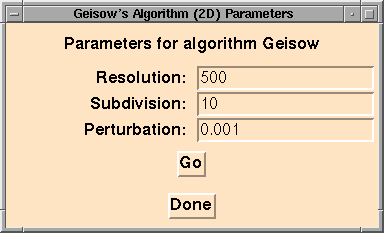Up to Pisces Online Documentation
Geisow's Algorithm
( also known as "2D Bernstein Method" )
Overview
This algorithm traces the level set of a POLYNOMIAL function of two
variables. That is, given a polynomial from R^2->R, this function
computes the algebraic variety associated to that polynomial.
This algorithm should NOT be used on functions that are not
polynomials.
How Geisow's Algorithm Works
Geisow's algorithm traces the zero set of an arbitrary polynomial
curve in a specified region of x,y space. It represents the
polynomial in the Bernstein basis { choose(N,i)(1-x)^{N-i}x^i },
because the coefficients of the polynomial in that basis have the
property that if ALL Bernstein coefficients have the same sign (pos
or neg), then the polynomial does not have any zeros on the interval
[0,1]. (The converse does not hold: there are Bernstein polynomials
with coefficients of different signs that have no zeros on [0,1].)
The algorithm is therefore:
Compute coefficients of polynomial in Bernstein form.
Check coeffs of 2D Bernstein polynomial
if they all have the same sign,
poly has no zeros ==> DONE
else
{
look at first partial derivatives (as Bernstein polys)
if they have coeffs of same sign
poly is monotone, therefore find zero and draw soln.
else
{
if we are in a small region of space,
draw linear approx to poly
else
chop 2D region into 4 subregions
recursively generate curve for those regions
}
}
End result: We either
- draw linear approximation to level curve
- give up because we've reached resolution limit
- throw the rectangle out because no root in the rectangle
Controlling the Algorithm From Pisces

The Pisces panel to Geisow's algorithm has 3 parameters:
- Resolution: This determines the size of a "small" region of space.
Specifically, let L = minimum side length
of initial bounding box.
We will subdivide the initial bounding box into subregions
until we have a subregion with side length less than
L /Resolution. We will then no longer
divide that region.
EXAMPLE: If you begin with a bounding box of unit length
and if Resolution = 100, then we will stop subdividing space
when we have a region with side length > 1/100.
DEFAULT VALUE: 500
- Subdivision: Similar to above, except that if we let L as above,
then if we have a region of space with side length less than
L / Subdivision, then we assume that we can approximate the
solution curve linearly on this domain. If Subdivision is equal
to Resolution, then we will not fill in any of the solution
until we have subdivided as far as possible. Usually, however,
we want to put in pieces of the solution curve (when applicable)
before subdividing to the limit, so we typically set
Subdivision
to be less than Resolution.
DEFAULT VALUE: 10
- Perturbation: Sometimes symmetries in the polynomial being studied
give us a misleading view of how the algorithm behaves. For example,
if the polynomial is singular at the origin, then the algorithm will
"locate" the singularity by virtue of the fact that the singularity
was on one of the grid points for the algorithm. In order to restore
genericity, we perturb the initial grid randomly. The size of this
perturbation will be smaller than the value of Perturbation.
EXAMPLE: A user has the bounding box set for
[0,1]x[0,1] with
Perturbation=0.1.
Then the algorithm will compute a new bounding box
with xmin chosen randomly in the interval [-0.1, 0.1],
with xmax chosen randomly in the interval [ 0.9, 1.1],
and similarly for ymin and ymax.
Known Bugs
Coefficients for the polynomial are determined numerically, so any
coefficient that has a magnitude less than about 1.0e-8 will get
truncated to 0.
The routine does not verify that the current function is a
polynomial. This is because a function like x + y^2 + A*sin(x)
may or may not be a polynomial, depending on whether A=0, and
whether x is a variable or a parameter.
Bug Reports
software@geom.umn.edu
Algorithm Implemented by
Frederick J. Wicklin
Acknowledgements
This code is based on an algorithm developed by A. Geisow
in his 1982 PhD thesis, "Surface Interrogation,"
University of East Anglia, (UK)
Dr. Ralph Martin (Dept of Computing Maths, University of Wales
College of Cardiff, Senghennydd Rd, Cardiff, CF2 4AG, United Kingdom)
kindly gave the Geometry Center code that implemented this algorithm.
The code was originally written for Sun PHIGS.
Many thanks to Drs. Geisow and Martin for agreeing to allow their
code to be incorporated into the Geometry Center code.
![[Pisces]](../../pix/pi.gif) The Pisces Home Page
The Pisces Home Page
![[HOME]](/pix/home.gif) The Geometry Center Home Page
The Geometry Center Home Page
Comments to: pisces@geom.umn.edu
Created Fri May 12 15:46:19 CDT 1995 by
Fredrick Wicklin
Converted to html on July 26, 1995 by Erik Streed
Last Modified: July 26, 1995
Copyright © 1995 by
The Geometry Center,
all rights reserved.


![[Pisces]](../../pix/pi.gif) The Pisces Home Page
The Pisces Home Page